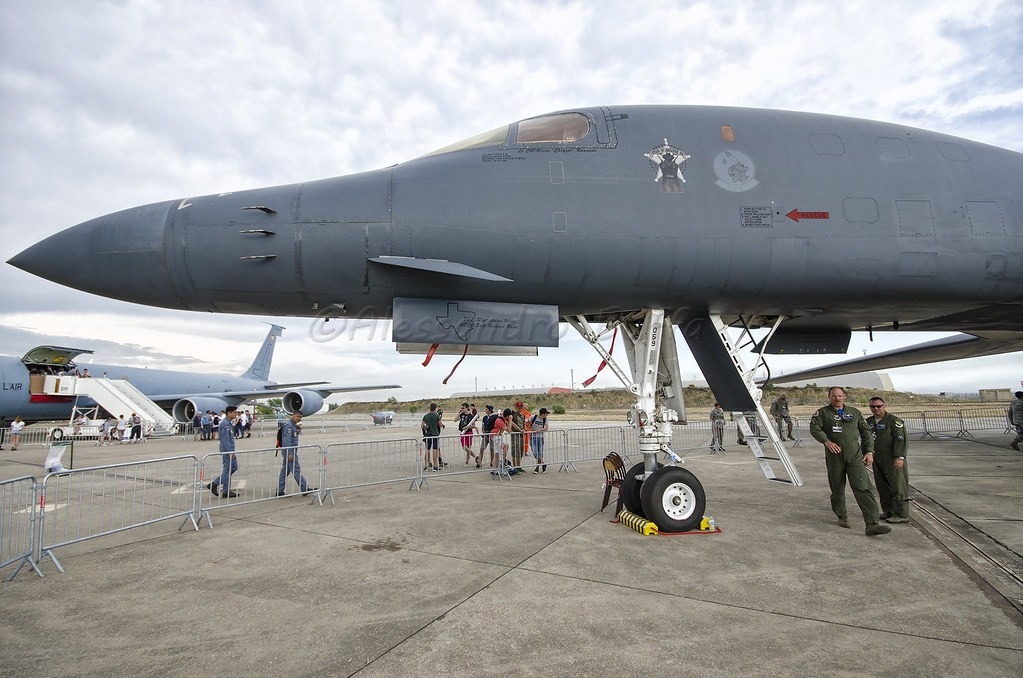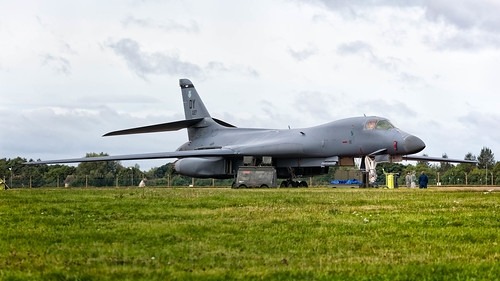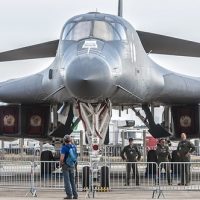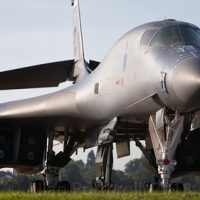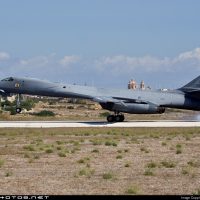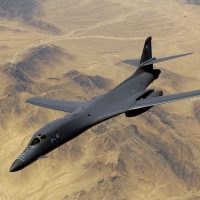Boeing (Rockwell) B-1B Lancer Specs, Price, Photos, & Details. B-1B Lancer was established by Rockwell International, now the Boeing Defense And Space Group, and is a long-term strategic bomber of the US Air Force. B-1B Lancer has the biggest internal load of all current bombers. The B-1B Lancer began operations in 1986. In July 2001, the US Department of Defense announced plans to reduce the inventory of the B-1B Lancer from 92 to 67 as a cost savings measure. The first aircraft was withdrawn from service in August 2002. After Operation Freedom of Iraq, it was decided that there must be 67 aircraft in the fleet.
The remaining fleets operate from Dyess AFB, Texas (38 aircraft) and Ellsworth AFB, South Dakota (29 aircraft). The Boeing B-1B Lancer is expected to become operational until 2025. In May 2010, the Boeing B-1 bomber completed its 25th anniversary of operations at Dyess US Air Force Base. Low radar sections, variable-geometry wings, modern avionics and afterburning engines allow the B-1 to strike the biggest load and offer cross countries, maneuverability, high speed and durability.
In March 2008, the Boeing B-1B Lancer became the first aircraft to come at supersonic speeds using synthetic fuel. Fuel is a 50/50 mixture of conventional JP-8 petroleum and synthetic fuels derived from natural gas using the Fischer-Tropsch process. This flight belongs to the ongoing USAF program to certify alternative fuels for all USAF aircraft.
Boeing B-1B Lancer Upgrade
In February 2009 Boeing received a $ 45 million agreement from the US Air Force to upgrade avionics software to B-1 bombers. The agreement ensures that the B-1 crew is well furnished to fulfill its growing role.
Boeing recently upgraded the B-1 aircraft with a fully integrated data link (FIDL) and upgraded aircraft took its maiden flight in July 2009. Updates featured modification of the cockpit, new processor, color display and communication architecture, improved B-1 crew ‘Situational awareness and communication capabilities and Ethernet networks.
The FIDL system reduces the workload of the crew by instantly reinstalling the weapon system. The Boeing Integrated Defense Sytems are expecting a November 2010 agreement from the USAF to install the FIDL system in its B-1 fleet.
The Sustainability Block Program (SBP) was launched in 2003. The program features an increase of 67 national B-1B Lancer long-range bombers with sophisticated avionics software every year.
In December 2007, a $ 45 million agreement was awarded to Boeing, due to the USAF, to improve the B-1B Lancer avionics bomber software as component of the SBP. The agreement allows work to begin on the SB14 Sustainability Block. SB 14 underwent flight tests at Edwards Air Force Base, California and was sent in 2011.
Boeing B-1B Lancer Specs
The Boeing B-1B Lancer is no more armed with nuclear weapons but is capable of carrying AGM-86B air launching cruise missiles (ALCM) and AGM-69 melee attack missiles.
This aircraft has three internal weapon bays and six external hardpoints under the fuselage. The maximum internal weapon load is 75,000 pounds and the maximum external weapon load is ₤ 59,000.
B-1B Lancer weapon payloads are: 24 GBU-31 combined direct attack (JDAM) at one time or a combination of 24 mk84 2,000 lb general purpose bombs, eight mk65 sea mines, 84 mk82 500lb general purpose bombs, 84 mk62 500lb mine naval, 30 CBU-87, -89, -97, 30 CBU-103, -104 cluster munitions, -105 wind-corrected ammunition dispensors (WCMD), 24 AGM-158 air joints to air stop missiles (JASSM) or 12 AGM-154 joint stand-off weapon (JSOW).
The B-1B Lancer aircraft is furnished with sophisticated AN/ AAQ-33 Lockheed Martin Sniper ATP targeting pods in June 2008. Snipers feature mid-wave FLIR (infrared looking forward), dual mode lasers, CCD-TV, laser spot trackers and IR Markers. The Sniper gives the B-1B Lancer the ability to self-identify targets and assess bomb damage. The first series of flight tests with the new pod took place in February 2007. The B-1B Lancer geared up with the ATP Sniper carried out its first operational deployment in August 2008 to support Operation Enduring Freedom.
The following are detailed Boeing B-1B Lancer specifications
- Function Long-range, multi-role, heavy bomber
- Four General Electric power plant F101-GE-102 turbofan engine with afterburners
Thrust 30,000-plus pounds with afterburner, per engine Wingspan 137 ft (41.8 m) extended forward, 79 ft (24.1 m) swept aft
Length 146 ft (44.5 meters).
34 ft Height (10.4 meters). - Weight Approximately 190,000 lbs (86,183 kg).
- Max Takeoff Weight 477,000 lbs (216,634 kg).
- Fuel Capacity 265,274 lbs (120,326 kg).
- Internal payload of 75,000 lbs (34,019 kg), 50,000 lbs (22,679 kg).
- Speed 900-plus mph (Mach 1.2 at sea level).
- Range Intercontinental. Ceiling More than 30,000 ft (9,144 m).
- Crew 4 (aircraft commander, copilot, and two weapon systems officers).
- Inventory 66.
Boeing B-1B Lancer Engine
The B-1B Lancer is furnished with four thrust F101-GE-102 30,000 lb engines from General Electric. Flight refueling containers allow refueling from KC-10 or KC-135 tankers. The B-1B Lancer can come at a maximum speed of 1,448 km/ hr. The service ceiling is 9,144 m. This aircraft weighs around 86,182 kg and the maximum takeoff weight is 216,363 kg.
Boeing B-1B Lancer Cockpit and Avionics
The aircraft is operated by four crews: pilot, co-pilot, defensive system operator (DSO) and offensive system operator (OSO). The DSO station is geared up with an interface for AIL Systems, the defensive avionics system ALQ-161 Inc. and the Honeywell multifunctional display that is connected to the aircraft aviation offensive aviation system (OAS). The OSO Station is furnished with two Honeywell multifunction screens that are connected to the OAS.
Rockwell Collins received an agreement in February 2004 to upgrade the display to a 5in × 7in multifunction display using active matrix liquid crystal (AMLCD) technology.
The EDO Corporation AN/ ALQ-161 defensive avionics provides interference with radar early warning and missile control radar and anti-air weapons. The processing algorithm is installed on IBM AP-101F digital computers. The system also includes Northrop Grumman interference transmitters, Raytheon phased array antennas and Doppler radar tail warning pulses, which provide rear hemisphere brain coverage.
Countermeasures for this system feature dispensers for bait that may be spent featuring chaff and flares. The defense system enhancement program (DSUP), which features radar AN/ ALR-56 and integrated ECM defensive ECE package (IDECM) BAE Systems, established for F/ A-18 fighter aircraft, is detained but may receive funds in the future.
The Northrop Grumman APQ-164 offensive radar system is a multi-mode radar with electronically scanned phased array antennas, which provide high-resolution terrain mapping, data speeds, flare modes, field avoidance, terrain tracking, position data, weather detection, meetings and modes calibration.
This aircraft has a Honeywell ASN-131 radar altimeter, Kearfott inertia navigation system, Northrop Grumman (Teledyne Ryan) APN-218 Doppler radar speed sensor (DVS), Honeywell APN-224 radar altimeter, Rockwell Collins ARN-118 TACAN tactical air navigation system and Rockwell Collins ARN-108 instrument landing system (ILS).
Communication suites consisting of ASC-19 AFSATCOM satellite communications, long-term ARC-190 HF radio Rockwell Collins, Honeywell KY-58 secure voice encryption device, Rockwell Collins ARC-171 UHF radio line-of-sight communication system, ARR-85 line system safe or open -of-sight and APX-101A IFF (identification of friends or enemies).
Boeing B-1B Lancer Price
The price of the most current Boeing B-1B Lancer aircraft ranges from US $ 315 – 350 Million.

